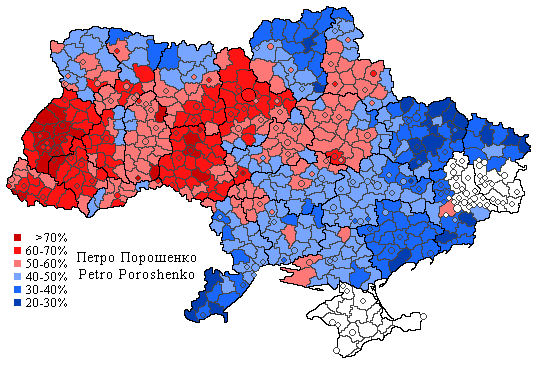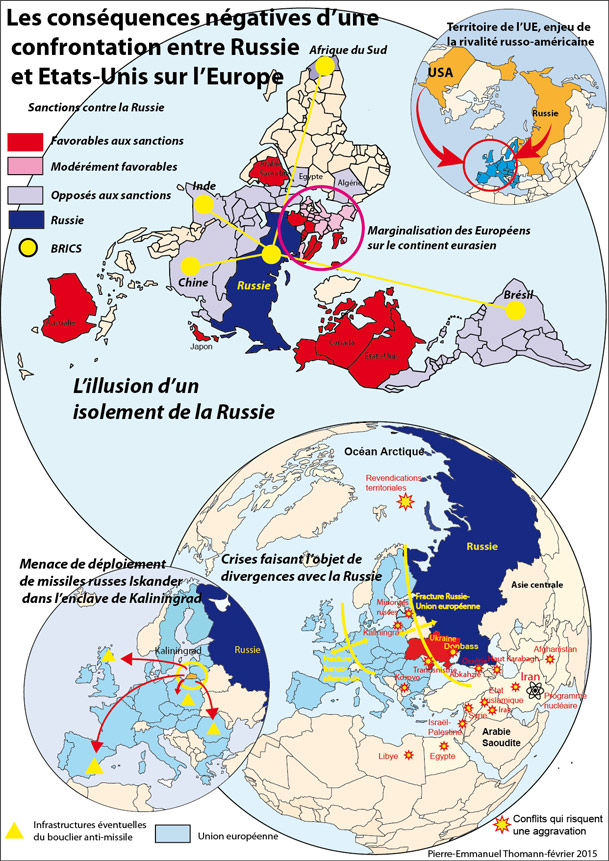Les accords de Minsk II pour résoudre la question ukrainienne sont susceptibles de faire évoluer la stabilité du continent européen dans deux directions différentes : le gel du conflit avec stabilisation lente et laborieuse de l’Ukraine ou une reprise de l’escalade militaire après une période de répit.
La situation évoluera en fonction de la volonté politique des européens d’ériger un projet d’ Europe européenne incluant la Russie et l’Ukraine dans une architecture renouvelée de taille continentale. Sans cette volonté politique, ces accords seront illusoires et les Européens se laisseront encore instrumentaliser par les puissances extérieures sans volonté d’agir sur leur destin et leur souveraineté.
Un sursaut vers l' « Europe européenne » ?
Les accords de Minsk II annoncent deux éléments extrêmement positifs : le premier accord entre Européens sans la participation des États-Unis pour le rétablissement de la stabilité sur le continent européen et la réaffirmation de l’axe franco-allemand. Ces évolutions seront-elles suffisantes pour inverser la déstabilisation rapide du continent eurasien par les stratégies euro-atlantistes ?
Les accords de Minsk II contrastent avec le fiasco de la médiation du 21 février des ministres allemands, français et polonais, la veille du Putsch contre le président Ianoukovitch. Les trois ministres n’avaient pas tenu parole et toute la méfiance sur le dossier ukrainien est en grande partie issue de cet épisode qui a souligné pour les Russes le double discours des gouvernements des Etats-membres de l’Union européenne.
La veille des accords de Minsk II, l’ombre des États-Unis a pourtant encore été présente avant la rencontre entre le président Poroschenko et Kerry et la visite d’Angela Merkel à Barack Obama.
C’est paradoxalement dans les moments les plus difficiles et lorsque les trajectoires des Allemands et des Français divergent le plus que le couple franco-allemand se met en scène. Le président François Hollande avait annoncé vouloir assouplir les sanctions dès le début de l’année contre la Russie et éviter d’ériger « un nouveau mur » tandis que la chancelière Angela Merkel voulait les maintenir. En savoir plus
Distortion of information about the Ukrainian crisis: Ukrainian army war crimes, flight MH17

Source: Alexander Kireev http://www.electoralgeography.com/new/en/countries/u/ukraine/ukraine-presidential-election-2014.html
Common sense suggests making the right diagnosis on a crisis situation before taking political decisions. A right understanding of facts on the ground and a balanced view of the situation is necessary to avoid mistakes. The crisis in Ukraine is a very bad example regarding these principles as objectivity has been rarely applied within the European Union. Preconceived ideas about the Ukrainian crisis from European Union Member States governments, but also huge media campaign of disinformation in the Western mainstream media have distorted many facts.
Omission of facts and biased information is harming the understanding of what is at stake in the Ukrainian crisis. It prevents the European Union Member States from taking the right decisions according to their own interests, and harm the credibility of the European project as a whole for its own citizens but also its neighbours.
To have more balanced information, it is nevertheless quite easy to highlight the huge contradictions of the information disseminated or omitted by the media or some EU Member States governments. Read more
La stratégie géopolitique globale des États-Unis a pour objectif prioritaire le contrôle de l’Eurasie sur la carte du monde. Avec une continuité remarquable, les États-Unis cherchent depuis près de deux siècles à éviter que n’émerge une puissance qui puisse défier leur statut de puissance mondiale sur ce continent. Les États-Unis ont ainsi combattu l’Allemagne de Guillaume II et ses visées impérialistes continentales à l’ occasion de la première guerre mondiale, l’Allemagne nazie et leur projet de domination de l’Eurasie à l’occasion de la Deuxième guerre mondiale en enfin l’URSS et ses visées expansionnistes pendant la guerre froide. Ils tentent aujourd’hui d’empêcher un rapprochement entre l’Union européenne et la Russie par l’élaboration de politiques aux conséquences déstabilisatrices pour une unification du continent eurasien comme l’élargissement de l’OTAN, le bouclier anti-missile et la tentative de détachement de l’Ukraine du monde russe.
Les gouvernements des États-Unis sont ainsi constamment tentés depuis les années 1950 au XXème siècle par l’endiguement et la politique de refoulement territorial de la Russie. Ces stratégies sont directement issues des représentations géopolitiques anglo-saxonnes dont les fondements ont été conceptualisés par Sir Halford Mackinder (le Heartland [1]), Nicolas Spykman (le Rimland) et plus récemment Zbigniew Brzezinski qui pointe à nouveau l’Eurasie comme le centre des stratégies géopolitiques américaines à l’échelle du monde. Ce politologue américain proche des administrations américaines et expert renommé dans les think tanks aux États-Unis a préconisé dès 1996 de former un axe constitué par la France, l’Allemagne, la Pologne et l’Ukraine pour faire rétrécir l’influence russe.
Dans les préconisations géopolitiques de cet auteur, les analogies avec la crise ukrainienne actuelle sont frappantes. En savoir plus
Mistrust about Eastern Partnership
The political crisis in Ukraine threatens the strategic relationship not only between UE and Ukraine, but also between EU and Russia.
Deep mistrust between Russia and European Union derives from the Eastern Partnership finality. According to a cable revealed from WIKILEAKS, the Eastern Partnership “aims to counter a resurgent Russia” by having a “pro-western buffer zone”. “The prospect of free trade zone and visa-free travel to the EU, the Eastern Partnership can spur the reforms needed for eventual membership and stem growing Russian influence”. The Eastern Partnership would “energize EU engagement with eastern neighbors in the face of enlargement fatigue”. The Eastern Partnership has also the support of the United States as they look “for ways to enhance western influence beyond NATO's eastern borders”.
The cable proves that Eastern Partnership finality, UE enlargement and finally NATO interests are strongly intertwined, and this can only enhance mistrust from the Russian side and pro-Russian populations within Ukraine.
The interest of EU and Ukraine
If the EU still harbours the strategic ambition to build a European political identity, it must be able independently to identify and defend its interests in the multipolar world that is taking shape. A realistic analysis of its interests suggests the following principle:
Renunciation of the enlargement of the EU and the Atlantic Alliance into Russia’s ‘near abroad’ is the way to increase regional stability and improve relations with Russia. With stable frontiers, the EU would put an end to its dilution, which is growing with successive enlargements. Its internal cohesion and also its identity, which is crucial for popular support, would be strengthened by this.
With enlargement to Ukraine, the EU would find itself facing the identity question between Russia and Ukraine. The pursuit of enlargement is today causing the EU to import the geopolitical fault-lines resulting from the historical frontiers which mark the Eurasian continent. This weakens the EU’s coherence and identity and increases the risks of dilution.
Leaving aside the Balkans, the negotiation of political alternatives to the prospect of enlargement would provide the occasion for the EU to fix its frontiers in order to preserve its cohesion, to strengthen its identity and facilitate the identification of its interests. Membership of the Atlantic Alliance has hitherto filled the role of ‘anteroom’ to the EU. The freezing of the Atlantic Alliance’s enlargement to Ukraine also enables the EU’s own project there to be halted. It is in the Union’s interest to reduce Russia’s perception of encirclement.
A deepening of relations with Ukraine, Belarus, Moldova, the Southern Caucasus and Central Asia can only last if Russia’s interests in the European puzzle are taken into account. Relations between Ukraine and the EU could be oriented in the direction of a ‘bridge’ rather than a ‘front’ against Russia. Russia firmly intends to remain a powerful geopolitical pole. It holds one of the keys to security on the European continent and will remain a major energy supplier to the EU whatever form diversification may take. An energy, industrial and political alliance with Russia is in the interest of the EU in extending its hinterland towards ‘Euro- Siberia’.
In the end, ambivalence about the prospect of EU enlargement to Ukraine can only foster mistrust between EU Members States themselves and modify the geopolitical balance between France and Germany within EU with a transfer of the center of geopolitical gravity of the European project to the East, at the expense of EU Southern Member States.
Reformulation of the Eastern Partnership
The Eastern Partnership needs therefore to be reformulated to remove distrust from the Ukrainian and Russian side. A three-way negotiation between EU, Ukraine and Russia is the best formula for success.
In parallel to a reformulation of the Eastern Partnership, the negotiation of a new Eurasian security architecture preserving Russia’s security interests would facilitate the stabilization of the EU’s continental hinterland. It would also be a favorable opportunity for the EU to make itself a centre of equilibrium alongside Russia which would constitute a useful counter-weight against other global powers.

